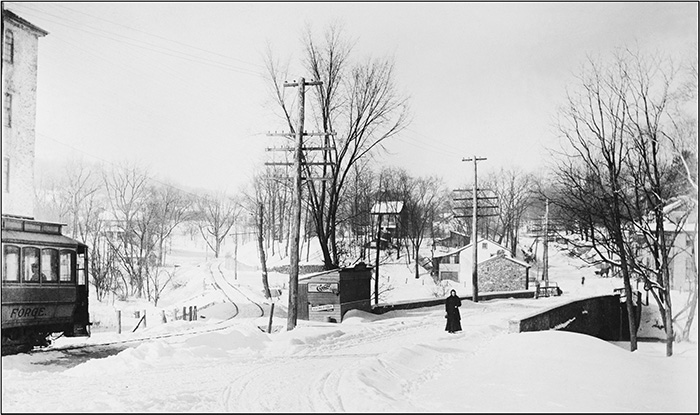|
Home : Quarterly Archives : Volume 41 |
Tredyffrin Easttown Historical Society |
|
Source: Summer 2004 Volume 41 Number 3, Pages 90–91 What's in a Picture?
This winter snow scene in Valley Forge looks west across the end-to-end bridges over Valley Creek and the western mill raceway and up the road toward Phoenixville. It is an example of how so much more can be "seen" in a photograph when it is converted to a large digital image that can be zoomed in on, and then how authoritative historical and Internet sources can provide additional information about the picture. The left edge shows a corner of the cotton mill and the first closed trolley car owned by the Phoenixville, Valley Forge and Strafford Electric Railway sitting at the eastern terminus of the line [see the sidebar on the next page] at the southwest corner of the intersection of present day Routes 23 and 252. By comparing the trolley car in this photograph with the pictures in the Bowman book on pages 60 and 64 it can be determined that this photograph shows the first closed car owned by the trolley line and that it is therefore likely to have been taken sometime between 1912 and 1915. The snow clearly shows the railway bridge over Valley Creek and the track leading off to Phoenixville. Zooming in on the road to Phoenixville, one discovers a horse and sleigh standing in front of the house up the hill from the P.O.S.A. hall on the right after crossing the bridge. The signs on the shed-like structure to the left of the woman in the middle of the bridge become legible after zooming in on them. The larger one on the top says "Eisenlohr's Cinco Cigars" and the smaller sign underneath says "Havana Ribbon." The "Eisenlohr" on the sign was only partially legible, even at the largest zoom, but a search for "Cinco Cigars" on Google on the Internet immediately brought up "Eisenlohr' which matched the partially legible name. The Internet further tells us that Otto Eisenlohr and Brother(s) had several cigar factories in this area, including ones near Ninth and Market and Callowhill Streets in Philadelphia, one in East Greenville Borough in Montgomery County, one in Reading, and one in Conestoga in Lancaster County. The Internet also told us that the sign in this photograph was bright yellow and red porcelain, measured about 36" x 12" and that, although most of them listed on various online auction sites in early September 2004 had already been sold - confirming the fact that old advertising signs are in great demand at this time - one was listed for bidding starting at $145. This is an example of how the details in a single photograph can provide a wider understanding of what it was like to live in the past.
PHOENIXVILLE, VALLEY FORGE AND STRAFFORD With the opening of the Philadelphia and Western Railroad in 1907 from 69th Street in Philadelphia to Strafford, Thomas O'Connell, a noted local railway developer, began promoting a new line to run from Strafford through Valley Forge to Phoenixville. It seemed like a good idea since Valley Forge Park continued to be a popular place to visit after the 1876 Centennial. Planning for the new line began at the Phoenixville end. By the Spring of 1911 the bridges for the track across Pickering Creek and Valley Creek were completed and in the Spring of 1912 service between Phoenixville and Valley Forge was initiated. According to Bowman (p. 64) the line came to an "abrupt halt just after crossing Valley Creek." The developers had not taken into account the fact that Philander C. Knox, a prominent Republican politician, had already donated the land needed for the right-of-way through the park to the state to be preserved as park land. Like most electric railways seeking to increase their numbers of riders, the P, VF & S started an amusement park a little over three miles in from each end of the line. It was called Valley Park and opened on August 4, 1912 with vaudeville acts and a picnic area. Eventually it expanded to include a merry-go-round, a movie theater, a dance hall, and a lake to go boating on. The line owned a total of 10 cars, 7 open excursion cars (pictured on p. 61 of Bowman) and 3 closed cars. From 1912 to 1915 they had only one closed car, car #6 (pictured on p. 60 of Bowman), originally built in 1894 and purchased used from the Philadelphia Electric Traction Company. They purchased the other two closed cars in 1915 new from the J. G. Brill Company of Philadelphia (pictured on p. 64 of Bowman). These were felt to be able to better handle the winter snows than the original closed car, which was only 18 feet long. The P, VF & S didn't have many riders during the winter months - keeping the line snow-free was a constant problem. And by 1919 the automobile was having an impact on all electric railways. Despite the fact that the line never raised its one-way nickel fare from each end of the line to Valley Park, the final run was made on December 24, 1923. Shortly after that, the railway track and bridge over Valley Creek were removed. Valley Park also closed when the railway line ceased operating. Today the park site is hidden by the woods on the south side of Valley Park Road west of the intersection with Country Club Road in Schuylkill Township and the entrance to the Fernleigh development of houses. A stone gate and stone building can still be seen from the road. SOURCES Stanley F. Bowman, Jr. and Harold E. Cox. Trolleys of Chester County, Pennsylvania. Forty Fort, Pa.: Harold E. Cox, 1975, pages 60-66. Herb Fry. "The Amusement Park on the Trolley Line." Tredyffrin Easttown History Club Quarterly, Vol. 30, No. 3 (July 1992), pages 87-100. |
